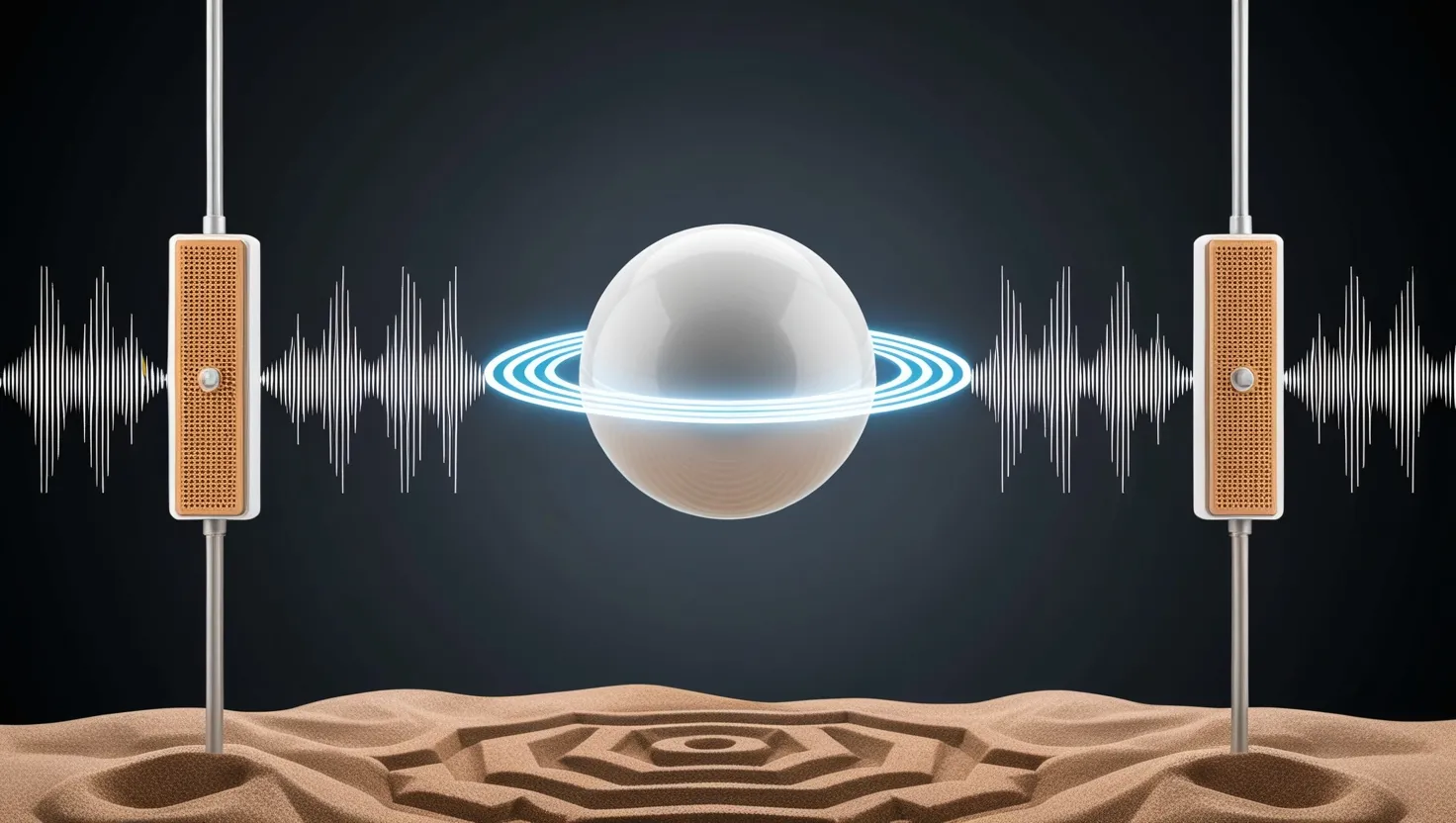Sound has always been a source of fascination for humans. From the earliest days of our existence, we’ve been captivated by the power of acoustic waves to shape our world in unexpected ways. But even today, in our age of scientific enlightenment, sound continues to surprise us with phenomena that defy easy explanation.
I’ve spent years studying these acoustic mysteries, and I’m continually amazed by how much we still have to learn. There are sonic effects occurring all around us that push the boundaries of our understanding of physics. Some of these phenomena hint at revolutionary new technologies, while others force us to question our most fundamental assumptions about the nature of reality itself.
Let’s dive into some of the most intriguing unexplained sonic phenomena that are baffling scientists and could potentially revolutionize physics as we know it:
Imagine being able to levitate objects using nothing but sound waves. It may sound like science fiction, but acoustic levitation is very real. By creating standing waves of sound, researchers have found ways to generate pressure nodes - pockets of stability where small objects can float in midair, completely defying gravity.
I’ve seen demonstrations where tiny polystyrene balls hover between precisely tuned speakers, dancing and spinning as if by magic. But it’s not magic - it’s the power of sound to create invisible force fields that can counteract gravity itself.
The applications of acoustic levitation are mind-boggling. We could potentially use it to manipulate hazardous materials without physical contact, or to study the behavior of materials in zero-gravity environments right here on Earth. Some researchers are even exploring ways to use acoustic levitation for 3D printing, building complex structures one floating particle at a time.
But the implications go far beyond just practical applications. Acoustic levitation challenges our understanding of the fundamental forces that shape our universe. If sound waves can counteract gravity so precisely, what does that tell us about the true nature of these forces? Could there be ways to manipulate gravity itself using acoustic principles?
“The day science begins to study non-physical phenomena, it will make more progress in one decade than in all the previous centuries of its existence.” - Nikola Tesla
What do you think - could acoustic levitation lead to revolutionary new technologies? Or does it hint at even deeper mysteries about the nature of reality?
Another sonic mystery that continues to baffle scientists is the phenomenon of sonoluminescence - the emission of brief flashes of light from imploding bubbles in a liquid when excited by sound.
Picture this: a tiny bubble in water, pulsing with sound waves. As the bubble collapses, it releases a burst of light brighter than the surface of the sun. It happens in an instant, on a microscopic scale, but the implications are enormous.
The temperatures reached inside these collapsing bubbles are estimated to be tens of thousands of degrees Kelvin - hotter than the surface of the sun. Some researchers have even suggested temperatures in the millions of degrees could be possible. But how can sound waves create such extreme conditions?
The honest answer is that we still don’t fully understand the mechanisms behind sonoluminescence. Some theories suggest it could be a form of quantum vacuum radiation, or even potentially a source of fusion energy. The phenomenon challenges our understanding of how energy can be concentrated and transformed.
I’ve spoken with researchers who believe sonoluminescence could lead to new forms of clean energy production, or provide insights into the conditions present in the early universe. Others see potential applications in medical imaging or water purification. But the truth is, we’re only beginning to scratch the surface of what this phenomenon could reveal about the nature of sound, light, and energy.
What’s your take - could sonoluminescence be the key to unlocking new forms of energy? Or does it point to even stranger aspects of physics we’ve yet to discover?
Have you ever seen sand on a vibrating plate form intricate, symmetrical patterns? This is the basis of cymatics - the study of visible sound and vibration. When materials vibrate at specific frequencies, they can form stunning geometric patterns that seem to defy explanation.
I’ve witnessed demonstrations where simple tone generators create mandala-like forms in sand or water. The patterns that emerge often match ancient sacred geometry or mathematical principles like the Fibonacci sequence. It’s as if sound is revealing some hidden order in the universe.
But cymatics goes beyond just pretty patterns. Researchers have found that certain frequencies can influence biological processes, potentially offering new approaches to healing. Others are exploring how cymatic principles could be applied to architecture or engineering, creating structures that are in harmony with natural vibrational frequencies.
The big question is: why do these specific patterns emerge? Are we seeing some fundamental organizing principle of the universe expressed through sound? Or could cymatics be revealing aspects of higher-dimensional geometry that we can’t normally perceive?
“If you want to find the secrets of the universe, think in terms of energy, frequency and vibration.” - Nikola Tesla
What patterns do you see in your life? Could understanding the hidden geometries of sound help us live in greater harmony with the natural world?
We tend to think of sound as something we can hear, but there’s a whole world of acoustic phenomena occurring below our auditory threshold. Infrasound - sound waves below 20 Hz - can have profound and sometimes unsettling effects on the human body and mind.
I’ve experienced infrasound firsthand in controlled experiments, and the sensations are difficult to describe. A feeling of unease, of being watched, of time slowing down or speeding up. Some people report seeing shadowy figures or feeling a presence in the room. It’s no wonder that infrasound has been linked to reports of hauntings and other paranormal experiences.
But the effects of infrasound go beyond just spooky sensations. Researchers have found that certain infrasonic frequencies can resonate with human organs, potentially causing physical discomfort or even damage at high intensities. There’s evidence that some animals use infrasound for communication over vast distances, and that it may play a role in atmospheric phenomena like the aurora borealis.
The implications are fascinating. Could we develop technologies to detect or manipulate infrasound for practical applications? Might it offer new insights into human perception and consciousness? Or could infrasound be the key to understanding certain unexplained natural phenomena?
What unseen forces might be influencing your perceptions right now? How might becoming more aware of the hidden world of sound change your understanding of reality?
Black holes have captured our imagination as cosmic objects that trap even light itself. But did you know that scientists have created acoustic analogs of black holes that can trap sound waves?
By carefully engineering metamaterials - artificial structures with properties not found in nature - researchers have created systems where sound waves behave similarly to light near a gravitational black hole. These “acoustic black holes” can bend and trap sound waves, potentially offering new ways to control and manipulate acoustic energy.
I find the concept mind-bending. We’re essentially recreating cosmic phenomena on a tabletop scale, using sound instead of gravity. The implications go far beyond just interesting physics demonstrations. Acoustic black holes could lead to new forms of soundproofing, acoustic cloaking devices, or even ways to harvest acoustic energy from the environment.
But perhaps even more intriguing are the theoretical implications. By studying these acoustic analogs, we might gain new insights into the behavior of actual cosmic black holes. Could there be fundamental similarities between gravity and sound that we’ve yet to fully understand?
“The most beautiful thing we can experience is the mysterious. It is the source of all true art and science.” - Albert Einstein
What other cosmic phenomena might we be able to recreate using sound? How might studying acoustic analogs change our understanding of the universe?
Our final sonic mystery challenges one of the most fundamental principles of classical physics - the idea that waves simply pass through each other without interacting. In certain non-linear acoustic systems, sound waves can actually generate completely new frequencies through their interaction with materials.
I’ve witnessed demonstrations where two pure tones combine to produce a third tone that wasn’t present in the original signals. It’s as if the sound waves are performing arithmetic, adding and subtracting to create new frequencies out of thin air.
These non-linear acoustic artifacts have practical applications in fields like medical ultrasound and acoustic testing. But they also raise profound questions about the nature of wave propagation and energy transfer. If sound waves can interact in such complex ways, what might that tell us about other types of waves - like light or even quantum waves?
Some researchers believe that studying non-linear acoustics could lead to breakthroughs in fields like quantum computing or advanced communications technologies. Others see potential for new forms of acoustic computing, using sound waves to perform complex calculations.
The phenomenon challenges us to rethink our assumptions about how energy and information propagate through space. Could there be hidden layers of acoustic complexity all around us that we’ve been missing?
How might understanding these non-linear interactions change the way we think about communication and information transfer? What other assumed “laws” of physics might turn out to be more flexible than we thought?
As we’ve explored these six unexplained sonic phenomena, I hope you’ve gained a sense of just how much mystery still surrounds the world of sound. From levitating objects to creating miniature stars, from revealing hidden geometries to mimicking cosmic phenomena, sound continues to surprise and challenge us.
These acoustic enigmas push the boundaries of our understanding of physics, forcing us to question fundamental assumptions about energy, matter, and the nature of reality itself. They hint at revolutionary new technologies and offer tantalizing glimpses into the deeper workings of the universe.
But perhaps most importantly, they remind us of the power of curiosity and wonder. In a world that often feels fully explored and explained, these sonic mysteries show us that there is still so much to discover. They invite us to keep questioning, keep exploring, and keep listening for the hidden harmonies that shape our world.
What sonic mysteries have you encountered in your own life? How might a deeper understanding of sound change the way you perceive and interact with the world around you? The answers may be more profound than you imagine.






